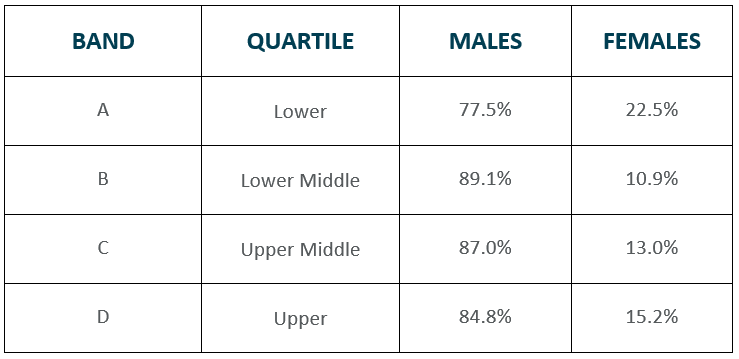Gender Pay Gap Report 2024
FOREWORD
At Vergo Pest Management Ltd, we remain deeply committed to fostering a diverse and inclusive workplace where all individuals have equal opportunities to thrive. Gender equality is fundamental to our values, and we are actively working towards reducing and ultimately closing the gender pay gap.
This report provides an analysis of our gender pay gap as of the snapshot date, 5 April 2024. It highlights our current pay gap metrics, provides an update on the gender distribution across our workforce, and outlines our ongoing initiatives to improve gender balance, particularly in higher-paid and operational roles.
METHODOLOGY
The figures in this report have been calculated in line with the statutory requirements for gender pay gap reporting. All employees (full-time and part-time) have been included, and the calculations are based on gross hourly earnings, excluding overtime but including other qualifying pay and bonuses.
PAY QUARTILES BY GENDER
This table shows our workforce divided into four equal-sized groups based on hourly pay rate. The Lower quartile includes the lowest-paid 25% of employees, and the Upper quartile covers the highest-paid 25%.

Despite some improvement in the Lower quartile, men continue to make up the majority across all pay quartiles. This distribution reflects the continued gender imbalance in the pest control industry and within our organisation.
OUR GENDER PAY GAP
This is our annual gender pay gap report for the snapshot date of 5 April 2024.
- Our mean gender pay gap is 3.9%.
This means that for every £1 a man earns at Vergo, a woman earns approximately 96.1 pence. This marks a significant improvement from 2023, when the mean pay gap was 10.38%. - Our median gender pay gap is 3.1%.
The median gender pay gap represents the difference between the middle male salary and the middle female salary. It is less influenced by outliers and provides a more typical view of pay disparity. This means that for every £1 a typical male employee earns at Vergo, a typical female employee earns approximately 96.9 pence, compared to 92.4 pence in 2023.
These figures represent a significant improvement from 2023, where our mean gender pay gap was 10.38%, and the median was 7.63%. The reduction to 3.9% (mean) and 3.1% (median) in 2024 highlights meaningful progress toward achieving greater gender pay equity across the organisation.
- Our mean gender pay gap in bonus pay is 68.1%.
On average, women’s bonuses are 68.1% lower than those awarded to men, meaning women receive approximately 31.9 pence for every £1 of bonus pay given to a male employee. This remains a key area for improvement and reflects the continued underrepresentation of women in senior and bonus-eligible roles. - Our median gender pay gap in bonus pay is 79.5%.
The median bonus amount that women receive is 79.5% lower than that received by men. For every £1 of bonus pay awarded to a male employee, a female employee receives just over 20 pence. This represents a widening of the median bonus gap from 2023 and highlights the need for further review of bonus allocation across the business. - The proportion of employees receiving a bonus was 83.1% for men and 80.0% for women.
This shows a slight increase in bonus eligibility for both genders compared to 2023, where the figures were 71.35% for men and 70.9% for women.
While the proportion of men and women receiving bonuses is now relatively balanced – with 83.1% of men and 80.0% of women receiving a bonus – the gap in the value of bonuses remains substantial. The mean and median bonus pay gaps indicate that men continue to receive significantly higher bonus payments than women. This disparity reflects the continued underrepresentation of women in senior and higher-paid roles where bonuses tend to be more substantial.
WHY DO WE HAVE A GENDER PAY GAP?
The gender pay gap at Vergo is primarily driven by structural and historical factors in our industry, including:
- Occupational Segregation: The pest control sector remains male-dominated, especially in operational and technical roles. We continue to see significantly higher numbers of men in our workforce (467 men vs. 85 women).
- Vertical Segregation: Senior roles that attract higher base pay and bonuses are still predominantly held by men. This directly impacts both pay and bonus gap statistics.
- Part-Time and Flexible Work: A higher proportion of our part-time roles are held by women. These roles may not offer the same earning potential or bonus opportunities as full-time or managerial positions.
- Bonus Pay Structures: The bonus gap reflects the underrepresentation of women in leadership and commercial positions where performance-based incentives are more substantial.
We are confident that our gender pay gap is not due to unequal pay for equal work. Instead, it is a result of gender representation across different roles and levels.
HOW DOES OUR GENDER PAY GAP COMPARE WITH OTHERS?
At the time of reporting, most of our workforce is operational and male in gender. However, our median gender pay gap is lower than the national average median gender pay gap, which is 14.3% (according to the October 2023 ONS ASHE figures) by 6.67%. The median gender pay gap has also decreased by approximately 42.63% year on year from 27% in 2021 and 13.3% in 2022 to 7.63% in 2023.
WHAT ARE WE DOING TO CLOSE OUR GENDER PAY GAP?
Vergo’s median gender pay gap of 3.1% is significantly lower than the national average of 13.1% (National Gender Pay Gap ONS ASHE 2024), demonstrating strong performance in pay equity relative to national benchmarks. Although the ONS does not consistently report a national mean pay gap for all employees, Vergo’s mean gap of 3.9% is also likely well below the national average.
The company’s median gender pay gap has decreased by approximately 88.5% over the past four years from 27% in 2021 to 13.3% in 2022, 7.63% in 2023, and now down to 3.1% in 2024,reflecting continued year-on-year progress.
OUR ACTIONS TO REDUCE THE GENDER PAY GAP
Our 2024 Gender Pay Gap report shows a continued and encouraging trend toward reducing gender pay disparity across the organisation. We are particularly proud of the progress in our median gender pay gap, which has decreased from 7.63% in 2023 to 3.1% in 2024, and in our mean gender pay gap, which dropped from 10.38% to 3.9% over the same period. These improvements reflect the impact of our ongoing commitment to gender equality in pay and opportunity.
However, we recognise that our bonus pay gaps remain significant, with a mean bonus gap of 68.1% and median bonus gap of 79.5%, highlighting the continued underrepresentation of women in senior and bonus-eligible roles. Addressing this imbalance is a key priority moving forward.
We are committed to doing everything we can to continue narrowing the gender pay gap. We know that progress is particularly challenging in a male-dominated industry, where attracting women into operational roles – especially those in the lower and lower middle pay quartiles—remains a barrier to broader gender equity.
We believe closing the gender pay gap requires a multifaceted approach. Our ongoing actions include:
- Conducting regular pay audits to identify and address disparities and eliminate gender bias;
- Implementing transparent pay frameworks to support fairness in progression and reward;
- Providing career development support to create pathways for women into middle and senior roles;
- Actively recruiting more women into front-line pest control roles to build representation at entry and operational levels;
- Continuing to address bias in recruitment, progression, and workplace practices, ensuring inclusive hiring and promotion processes.
We know that achieving a representative gender balance is crucial to closing the gap-not only at the operational level but across all areas of the business. We aim to build a stronger internal pipeline of female talent for future leadership by increasing the number of women in operational roles.
No single initiative will eliminate the gender pay gap on its own, and we understand that real, lasting change takes time. However, we remain firmly committed to measuring our progress, acting on the insights gained, and holding ourselves accountable year on year.
We are proud of our progress but recognise there is more to do. Closing the gender pay gap is a long-term commitment, and we will continue to implement meaningful change to drive equality at all levels of our organisation.

James Gilding, CEO
Vergo Pest Management Ltd
View our previous Gender Pay Gap Reports:
